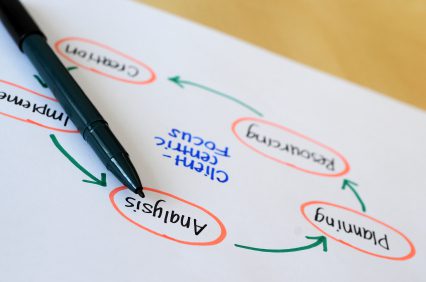The initial step of every project is an idea but for it to be productive and reach completion, it needs a comprehensive business plan or charter. A well thought out charter is essential in the initiation process of a new project. A project charter is that document which outlines the goals, responsibilities, the people involved in the project and their roles. It also talks about the finances, the term agreed upon and establishes the authority of the project manager. This document is usually initiated by the project owner and is the final document that can be used to measure the work done to the targets that need to be achieved for the successful completion of a project. Its lifecycle is as long as that of a project.
The management processes used are segregated into elements to create a step by step process of handling various aspects of the project. The main elements that are a part of the basic framework of any project are :
- Initiation
- Planning
- Execution
- Monitoring
- Completion
What does an initiation process do?
The initiation process is a critical piece of a project. The loss of time and resources due to a sloppy initial review cannot be recovered during the time frame needed to complete the rest of the processes. As part of this process group, a review of the business requirements is done to create measureable goals. Financial analysis and an analysis of the personnel to be a part of the project. It also includes the project charter. This topic is of great importance in all project management training programs.
What does a project charter contain and why is it needed?
A project charter is a critical document as it provides a comprehensive review of the project that includes
- A description of the scope of the project and its key requirements needed for the successful completion.
- It outlines the goals and the long term benefits to the organization
- A financial analysis to determine an approximate costing. A rough budget estimate could include a list of the resources needed, costs – human and otherwise.
- It contains time frames for the completion of some project requests. Targets that need to be reached for the completion of a part of the process can be set. These will be the means for the measurement of the success of the project and also as a means to study and review the progress made up to that time. A scoring system could be added for each process to give a clearer idea.
- It contains information about the key people who are to be a part of the project and their responsibilities. It also defines the level of authority of the project manager.
- It includes steps that need to be taken for the next elements of the process group to be initiated. Products or resources needed for the project delivery process are identified.
- It may also include an assessment of the potential risks involved at various stages of the project.
Once the final document has been approved, changes are rarely, if ever, made to the scope of the project. The responsibility of the project is with the project initiator who speaks to the stakeholders and the other players and after the project terms are agreed upon starts the draft of the charter.
A standard company template could be used to standardize content across various channels while keeping the charter concise and effective. A standard template would contain the following headings
- A brief description of the project
- A brief list of benefits of the project to the company and why it should be taken up.
- Scope of the project
- Milestones to be reached
- Resources needed and costs
- Measurement of progress made
- Roles and responsibilities
- An outline of the risks involved
- Agreement form for all the members involved
To be used as an effective communication tool, the project charter would be most useful if it is placed in a location that is easily accessible to all the members involved. For the project to be managed online, there are a number of apps and tools available across various operating systems that make it easily accessible to the project stakeholders, designers, freelancers and the management.



